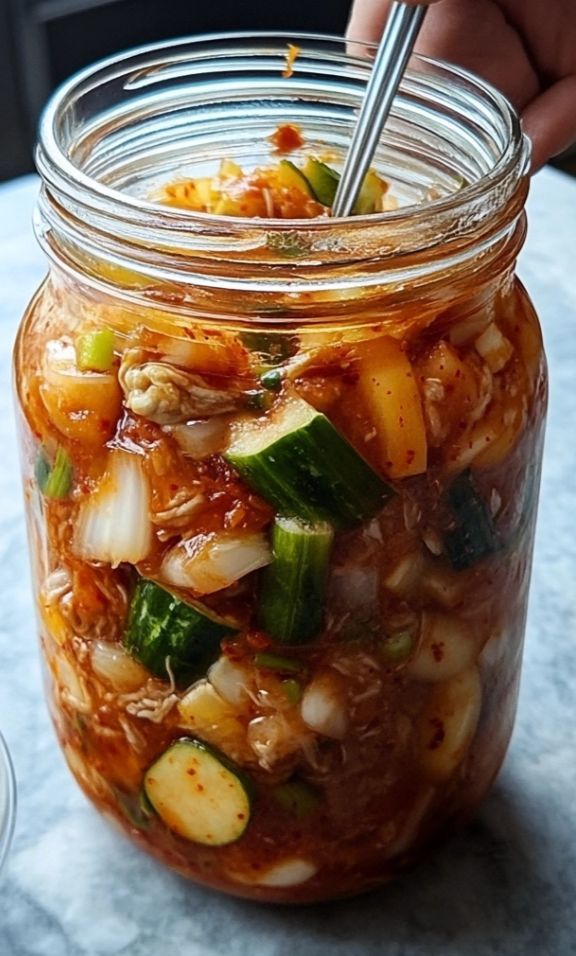ADVERTISEMENT
### Instructions for Jean’s Kimchi Recipe:
#### 1. **Prepare the Napa Cabbage:**
– Slice the napa cabbage into quarters, then cut the quarters into bite-sized pieces (about 2-inch pieces). Remove the tough core and outer leaves if needed.
– Place the cabbage in a large bowl, and sprinkle the sea salt evenly over the cabbage. Gently massage the salt into the leaves to ensure it’s well-distributed. The salt will help to draw out water from the cabbage, making it more pliable and allowing for proper fermentation.
– Cover the bowl with a clean towel and let it sit for 1-2 hours. During this time, the cabbage will soften and release moisture.
#### 2. **Make the Kimchi Paste:**
– While the cabbage is salting, make the flavorful paste that will coat the cabbage.
– In a small bowl, combine the minced garlic, grated ginger, fish sauce (or soy sauce), gochugaru (Korean red pepper flakes), sugar, and rice vinegar. Stir the ingredients together until you form a smooth paste. Adjust the amount of gochugaru for more or less heat, depending on your preference.
– Optional: Add julienned carrots to the paste for extra flavor and crunch.
#### 3. **Rinse the Cabbage:**
– After the cabbage has rested and softened, rinse it thoroughly under cold water to remove the excess salt. This will prevent the kimchi from becoming too salty.
– Drain the cabbage well and press out any excess water. You can use a colander or a clean kitchen towel to squeeze out the moisture.
#### 4. **Coat the Cabbage with the Kimchi Paste:**
– Now that your cabbage is ready, it’s time to mix it with the kimchi paste. Put on a pair of kitchen gloves (to protect your hands from the spicy gochugaru) and begin massaging the paste into the cabbage. Be sure to coat every leaf evenly with the paste.
– Once the cabbage is well-coated, add the chopped green onions and mix again to combine everything evenly.
#### 5. **Ferment the Kimchi:**
– Transfer the coated cabbage into an airtight glass jar or container. Pack it tightly to remove air bubbles, and leave about an inch of space at the top for the kimchi to expand as it ferments.
– Leave the jar out at room temperature for 1-2 days to ferment. The length of time depends on how sour and fermented you like your kimchi. After the initial fermentation period, you can refrigerate it to slow down the fermentation process. Kimchi can last for weeks in the fridge and the flavors will continue to develop over time.
#### 6. **Serve and Enjoy:**
– Once your kimchi has fermented to your liking, it’s ready to serve! Enjoy it as a side dish with rice, add it to soups, or even use it as a topping for tacos, burgers, or salads.
– For added flavor, sprinkle a few sesame seeds on top before serving.
### Tips for Perfecting Jean’s Kimchi Recipe:
1. **Fermentation Time**: The longer kimchi ferments, the tangier and more complex the flavors become. Taste it every day to find the perfect level of fermentation for your liking.
2. **Storage**: Store kimchi in a glass jar with a tight lid in the refrigerator to preserve its flavor and texture. Always make sure the kimchi is submerged in its own juices to prevent it from drying out.
3. **Adjust Spice Level**: If you’re not a fan of spicy food, reduce the amount of gochugaru or omit it entirely. You can also experiment with other seasonings to make it your own.
4. **Wear Gloves**: The gochugaru can stain your hands and cause irritation, so it’s best to wear disposable gloves while handling the paste.
5. **Use Fresh Ingredients**: Fresh garlic, ginger, and vegetables are key to bringing out the best flavor in your kimchi.
### Conclusion:
Jean’s Kimchi Recipe is a straightforward, flavorful way to enjoy this beloved Korean dish right in your own kitchen. The combination of spicy, tangy, and umami-rich flavors will elevate any meal, and the fermentation process offers numerous health benefits for your gut and immune system. Best of all, it’s easy to make and can be customized to suit your taste preferences.
Give this recipe a try, and watch your kitchen come alive with the vibrant flavors of homemade kimchi! Whether you’re new to kimchi or an experienced enthusiast, this recipe is a must-try for anyone looking to bring a little Korean flavor into their home cooking. Enjoy!
ADVERTISEMENT
ADVERTISEMENT
